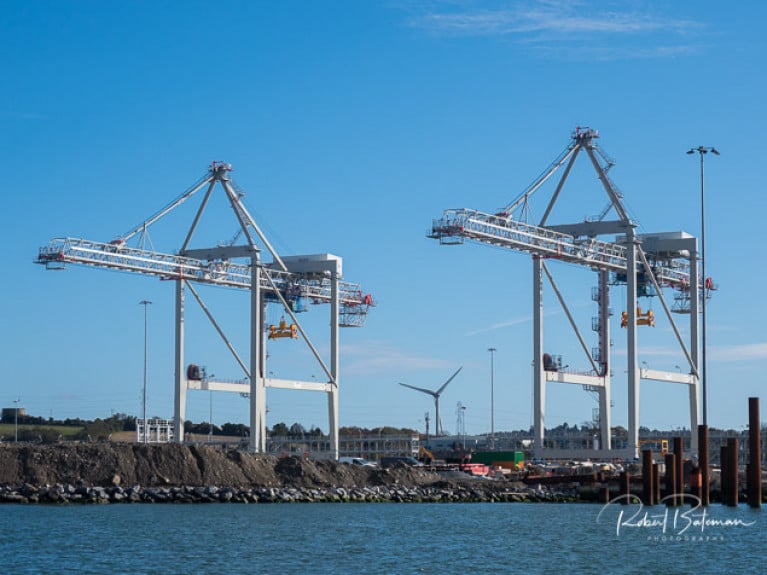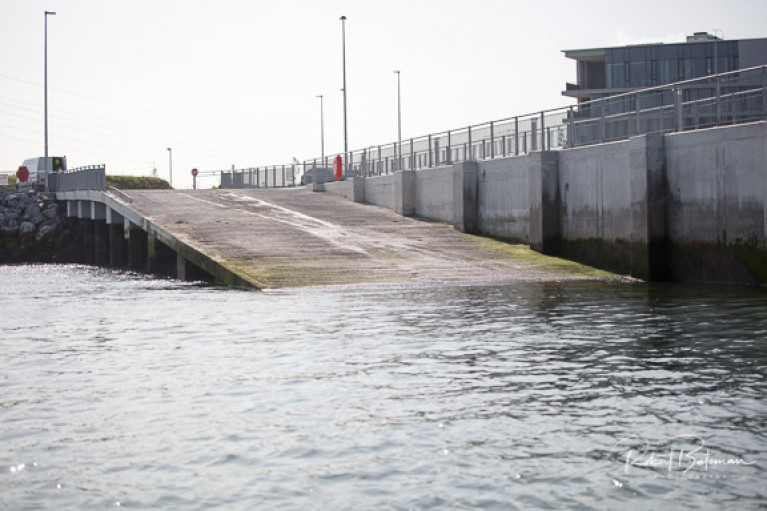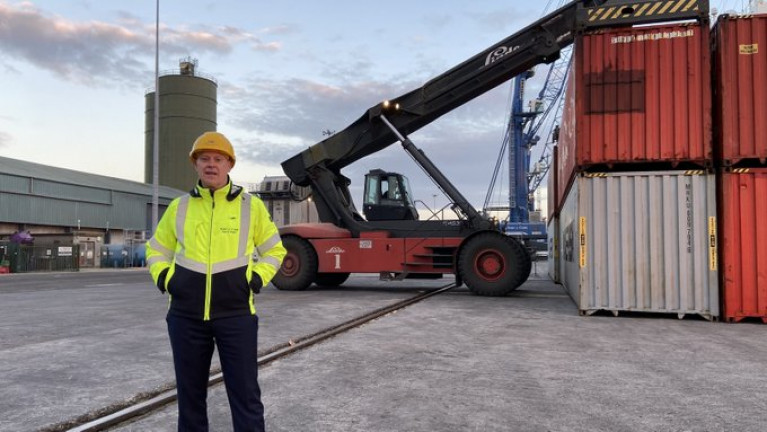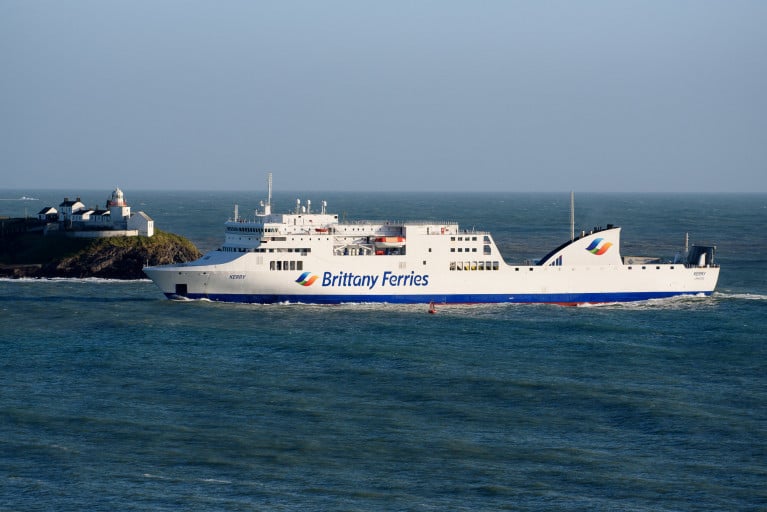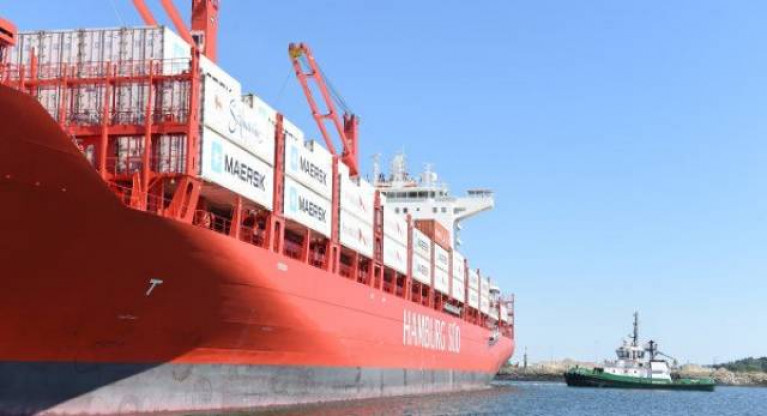Displaying items by tag: port of Cork
Port of Cork & CLdN Announce Second Call from Cork to Zeebrugge
The Port of Cork has welcomed CLdN’s decision to add a second weekly call from Cork to Zeebrugge to cope with the increasing demand on the current route. Adding a second call will offer CLdN customers a quicker turnaround, as well as bypassing the UK land bridge and avoiding unnecessary border checks, ensuring cargo flows more effectively and in a cost-efficient manner from Ireland direct to the continent.
The Cork to Zeebrugge Ro-Con service which started in May, as Afloat reported here, has been very popular with customers, who now welcome the second service offering them even more flexibility.
Conor Mowlds, Port of Cork Chief Commercial Officer said: ‘This is very exciting news for Cork and indeed importers and exporters utilising the current service. Added frequency offers flexibility and with more and more cargo looking to avoid the UK land bridge, this second Cork to Zeebrugge service is another step forward in ensuring supply chains are maintained.’
 The cargo supply vessel Evita moored in Cork Harbour this week. The Port of Cork is Ireland’s primary southern gateway Photo: Bob Bateman
The cargo supply vessel Evita moored in Cork Harbour this week. The Port of Cork is Ireland’s primary southern gateway Photo: Bob Bateman
He continued: ‘In these extraordinary times a second direct Ro-Con freight link with Europe from Cork, Ireland’s primary southern gateway reinforces our commitment to supporting businesses in the region and preparing for any eventuality Brexit may bring.’
A spokesperson from CLdN stated: ‘As we have shown and continue to deliver, we will deploy larger vessels or add more frequency to match demand to and from Ireland and will react immediately the market signals a requirement, as we see the Irish market as a core route in our portfolio.’
Busy Port of Cork as 'Independent Quest' Arrives from America & Liebherr Ship Cranes to Somaliland
There are busy scenes at the Port of Cork this week where Liebherr cranes are being assembled before shipment at Cork Dockyard later this month.
Eight Liebherr 'Ready to Go' (RTGs) have been assembled and are being finalised for sea transport to DPWorld Somaliland, according to social media posts by Liebherr Maritime Ltd.
On Saturday, (17th October 2020) Cork Harbour also welcomed Independent Quest, her maiden visit to Cork as part of the new Trans Atlantic-Ireland shipping route.
 Progress continues on the development of the new Port of Cork terminal with the two new Liebherr post-Panamax size ship-to-shore (STS) container gantry cranes (left) and Pont Aven ferry in berth (right) Photo: Bob Bateman.
Progress continues on the development of the new Port of Cork terminal with the two new Liebherr post-Panamax size ship-to-shore (STS) container gantry cranes (left) and Pont Aven ferry in berth (right) Photo: Bob Bateman.
As Afloat reported previously, progress also continues apace at the new Port of Cork Container terminal in Ringaskiddy with the new giant gantry cranes at work, a clear sign of headway at the Terminal. The cranes improve liners’ schedule reliability and reduce trade costs, and inventory holding outlays for shippers.
The Port is investing €80 million in the new terminal It offers a 360-metre quay with 13-metre depth alongside and enables larger ships to berth in the port.
 Pont Aven ferry (left) and Independent Quest cargo ship (right) safely docked after passage from USA Photo: Bob Bateman
Pont Aven ferry (left) and Independent Quest cargo ship (right) safely docked after passage from USA Photo: Bob Bateman
Impressive New Port of Cork Liebherr Cranes on the Cork Harbour Skyline
The two new Liebherr post-Panamax size ship-to-shore (STS) container gantry cranes make an impressive sight cutting the Cork Harbour skyline at the Cork Container Terminal (CCT) in the Republic of Ireland.
Port of Cork took delivery of the gantry cranes at the terminal in February this year and they were assembled on-site as Afloat reported here.
The cranes improve liners’ schedule reliability and reduce trade costs and inventory holding outlays for shippers.
 The post-Panamax Port of Cork Cranes Photo: Bob Bateman
The post-Panamax Port of Cork Cranes Photo: Bob Bateman
More Liebherr cranes are currently being assembled at Cork Dockyard in the harbour as Afloat reports here.
Construction on CCT began in June 2019 and will finish in 2020. The €80m project will initially offer a 360-metre-long quay with a 13-metre depth alongside.
The Cork Harbour development also includes the construction of a 13.5-hectare terminal and associated buildings.
Port of Cork Company Appoints New Chief Executive, Eoin McGettigan
The Port of Cork Company has appointed Eoin McGettigan to the role of Chief Executive of the company. Eoin replaces Brendan Keating who retired recently after 18 years of service as CEO.
The Chairman of the Port of Cork Company, John Mullins stated that ‘Brendan Keating made an outstanding contribution to the Port as Chief Executive since 2002. Brendan has seen the Port’s Strategic Development Plan fully recognised: the acquisition of Belvelly Port Facility (formerly Marino Point), the Inner Harbour Development at Bantry Bay Port Company, the marked increase in cruise business and the commencement of construction of the €86 million Cork Container Terminal in Ringaskiddy which will future proof the port. I have no doubt that Eoin will now take these projects and the business forward to further enable our growing economy.’
Eoin has spent the last decade providing strategic advice to a wide variety of companies. He has thirty years’ experience as a Senior Executive in Retail, Wholesale and Property businesses. He has held senior board positions in Musgrave PLC as Chief Executive of Supervalu Centra, Director of Dunnes Stores and Director of Reox Holdings PLC. Eoin and his family have lived in Cork for over 30 years.
John Mullins said: ‘Eoin brings with him a wealth of Senior Executive experience, excellent leadership skills and an integral knowledge of modern supply chains and logistics. He joins the Port at a strategic and exciting time for the company and the Southern region. The board and all in the Port company wish him every success.’
He added “Eoin will steward the company from the River to the Sea through the commissioning of key infrastructure in the lower harbour whilst making available former assets for critical residential and commercial development. Eoin’s property experience will be instrumental in ensuring that Tivoli will be one of the most exciting projects in the future for the company and for the City of Cork.’
Eoin McGettigan takes up the position as Chief Executive on 1st October 2020 for a term of five years.
Cork Harbour's Impressive Slipway & Marine Facilties at Paddy's Point in Ringaskiddy
As Afloat reported in July, the new public recreation area at Paddy's Point in Cork Harbour now has a new floating pontoon added to the existing marine leisure facilities at Ringaskiddy.
As it turns out, the new facilities were about to be put to championship use in August to handle a fleet at the Laser National Championships until the event had to be cancelled by Royal Cork Yacht Club due to COVID concerns.
The pier and slipway, that opened in May 2019 is located adjacent to the Beaufort Building in Ringaskiddy and is managed and maintained by the Port of Cork.
The substantial new facilities replace the existing Ringaskiddy slipway and pier and were completed as part of the Cork container terminal development.
 This new marine leisure facility is free for the public to use and includes a pontoon to launch leisure craft Photo: Bob Bateman
This new marine leisure facility is free for the public to use and includes a pontoon to launch leisure craft Photo: Bob Bateman
These latest photos of Paddy's Point further illustrate what a fine structure is now in situ and what a welcome addition it is to Cork Harbour's marine infrastructure.
The Port of Cork has announced the start of a new weekly direct service from Cork to USA, giving Ireland its first direct container service to the USA in many years.
The new Cork Harbour service is set to commence with the sailing of the ‘Independent Vision’ on June 6th. ICL will sail from the Port of Cork every Saturday arriving on the East Coast of the USA 10 days later, offering Irish exporters the most reliable and fastest delivery times for their supply chains.
CEO of the Port of Cork, Brendan Keating said: ‘The Port of Cork is delighted with this opportunity to work with ICL and support this new direct route to the US. The timing is perfect with the opening of our new €80 million Cork Container Terminal in Ringaskiddy on the horizon and has the potential to grow cargo volumes from and to Ireland. This is a fantastic strategic development for the Port of Cork as we look to develop Ringaskiddy as a modern logistics hub.’
CEO of ICL John Kirkland said: “Ireland is a market we have been keen to develop for a while and we sincerely hope the Irish trade support this commitment by ICL, to bring Ireland its first direct weekly service to the USA East Coast. We look forward to working with the Port of Cork with their exciting expansion plans”
ICL has been serving the North Atlantic trade for 35 years and is consistently named the most reliable carrier.
A survey by international transport engineering and consulting group SYSTRA, into the Port of Cork’s export and import facilities has yielded very positive results. Those surveyed, predominately LoLo HGV drivers, noted the Port’s desirable location, timesaving vehicle booking system, and efficient gate operations.
The forthcoming transfer of container operations from Tivoli to Ringaskiddy generated improved sentiment with positivity increasing by 42% since the initial 2015 survey. The redevelopment of Ringaskiddy and arrival of the new €80m Cork Container Terminal, Western Europe’s newest container terminal, garnered positive opinion as a “brilliant idea” with its “better location” from respondents. CCT will allow the port to handle larger vessels and facilitates the move from a river port to a deepwater port in order to future proof the Port of Cork.
The Vehicle Booking System (VBS), implemented in 2018 and a key component of the Port’s mobility management plan, was commended by 96% of respondents. Hauliers frequently highlighted the shorter turnaround times, and a substantial percentage observed reductions in queuing time. To date, the Port of Cork has invested over €1 million on trialling and implementing the traffic management plan with Cork County Council in order to minimise the impact of port-related traffic on local road networks.
The survey also highlighted what hauliers would like to see improved. Most notably, there was a strong desire to reduce traffic congestion and to see the upgrade of the N28 motorway become a reality. The Port of Cork fully recognises these concerns, and will continue to fully support the relevant agencies to do what’s needed to unlock Munster and Ireland’s latent economic growth.
Capt. Paul O'Regan, Harbour Master and Chief Operations Officer of Port of Cork, commented: “The 2015 survey offered some real insight into areas of growth for us. Although we are pleased that our hard work has paid off in many areas, we won’t be resting on our laurels. The insights we’ve gained from this report will further improve our resiliency, and we remain confident that we can continue to manage the disruption stemming from Covid-19 and keep Munster’s supply chain moving”.
Conor Mowlds, Chief Commercial Officer of the Port of Cork added: “We’re pleased with the positive responses from hauliers who use the port regularly. The VBS results were a particular highlight. It has consistently reduced queuing, lowered emissions, and improved turnaround times. Technological innovations, such as VBS, are ensuring that we can safely and efficiently maintain the flow of essential goods to southern Ireland in these unprecedented times.”
SYSTRA was commissioned by the Port of Cork to undertake the survey at Tivoli docks in order to develop a comprehensive understanding of the current container operations customer base, and to capture these customers’ views and opinions of Tivoli docks and the transfer of the container terminal from Tivoli to Ringaskiddy. A similar exercise was undertaken by SYSTRA in 2015.
Operators of Dublin and Cork ports have said imports of food and other essential items have increased since the Covid-19 outbreak here over a month ago.
According to RTE News, the ports said contingencies are in place to ensure ports stay open and supply chains remain intact.
Their trading figures indicate the Covid-19 outbreak has seen increased demand for food and other essential items.
This is backed up by evidence of panic buying and empty supermarket shelves.
The Port of Cork insists that trade is up and supply chains have been unaffected by the coronavirus outbreak.
At Cork's deep water terminal in Ringaskiddy, unloading of a Portuguese cargo ship, AS Petronia, began at 5am.
The ship left Costa Rica in Central America a fortnight ago, and tied up in Ringaskiddy in the early hours of this morning.
Ireland is its first port of call. The ship is carrying more than 2,000 shipping containers which are destined for ports all over Europe.
There were around 100 shipping containers for Ireland on board, carrying mangos, melons and pineapples, along with four million bananas - a mere week's supply to keep this country going.
More on this story by clicking here.
Port of Cork Responds to Brittany Ferries Decision To Finish the Cork to Santander Ferry Route
The Port of Cork have been informed by Brittany Ferries that the weekly Ro-Pax ferry service from Cork to Santander which includes a midweek Roscoff sailing is to cease operating. In a statement, the Port said: 'This surprising decision by Brittany Ferries is very disappointing, however, we will continue to pursue other options for linking Cork and Northern Spain".
As Afloat reported yesterday, Brittany Ferries is believed to be looking at moving the operation to Rosslare Harbour.
A Port spokesman added: "We remain supportive of Brittany Ferries who have operated out of Cork for over 40 years and we will continue to facilitate Brittany Ferries on their weekly service from Cork to Roscoff re-commencing in March 2020"
Buoyancy in Container (LoLo) Traffic a Positive for Port of Cork
The Port of Cork has reported that the combined total traffic through both the Port of Cork and Bantry Bay Port Company took a dip of 5% from 10.6 million tonnes, to just over 10 million tonnes in 2019. The cause for this minor decline is attributed to less volumes of dry bulk cargo through the port. Overall total imports decreased by 7% while exports decreased by 3%.
A key area, particularly for the Port of Cork as they look to complete and open Cork Container Terminal in 2020, was the continued increase in container or LoLo traffic in 2019. Over 240,000 TEUS were handled in 2019, a 5% increase on the previous year.
Brendan Keating, Port of Cork Chief Executive said: ‘2020 will be a significant year for the Port of Cork as we prepare to complete and open the €86 million Cork Container Terminal development in Ringaskiddy, so seeing continued growth in container volumes through both Tivoli and Ringaskiddy is very encouraging.’
"2020 will be a significant year for the Port of Cork as we prepare to complete and open the €86 million Cork Container Terminal development in Ringaskiddy"
He continued: ‘Once operational the new terminal will enable the port to handle up to 450,000 TEU per annum. We already possess significant natural depth in Cork harbour, and our work in Ringaskiddy Port will enable us to accommodate vessels of 5500 to 6000 TEU, which will provide us with a great deal of additional potential for increasing container traffic.’
In 2019 oil traffic handled through Whitegate Oil Refinery owned by Canadian company Irving Oil, saw a decrease of 9% partially due to a planned maintenance shut down in August.
In 2019 the Port of Cork handled 100 cruise liners bringing over 243,000 passengers and crew to the region, while Bantry Bay Port Company welcomed 10 cruise liners to the harbour town. In 2020 a record 102 cruise ships are scheduled to call between March and December.
The Port of Cork jointly with Lanber Holdings purchased Marino Point in 2017 and following consultation with Belvelly Marino Development Company, stakeholders, residents and a design team, the Belvelly Port Facility Masterplan was developed. The masterplan sets out the strategic approach of Belvelly Marino Development Company and is a guide to the future development of Belvelly Port Facility. It is envisaged that Marino Point will be developed to accommodate a range of industrial and port related activities and could become a dynamic industrial hub for the area, thus creating employment.
Brendan Keating said: ‘As part of the Project Ireland 2040 National Planning Framework, one of the key future growth enablers for Cork is to deliver large scale regeneration projects for the provision of new employment and supporting infrastructure in Cork Docklands, as integrated, sustainable developments, including relocation of sites from the City Docks. Belvelly Port Facility has been identified to enable this type of growth.’




























